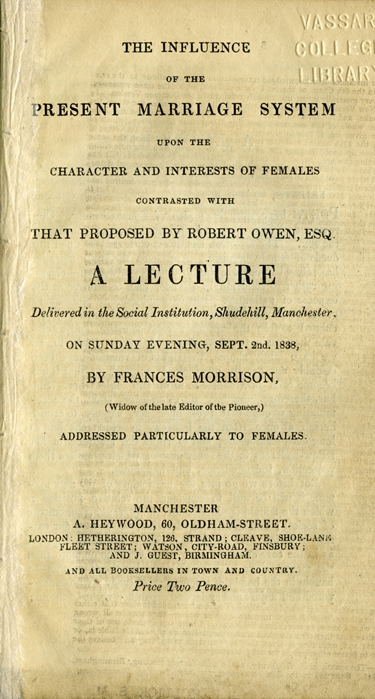Owen and Equality

If, as Owen believed, environment conditioned the development and behavior of human beings, then it followed that those humans marginalized by English society might thrive under other circumstances. Working class children with the benefit of education could demonstrate unexpected intellectual prowess. Owen's new science of society was also a tool for women to begin the task of dismantling old structures of prejudice. In his schools boys and girls wore identical garments that he had fashioned. And while Owen himself might act in a paternalistic manner towards those around him, within his movements feminists found a home (Marie Duclos Fretageot, Ernestine Rose). The case of Frances Morrison, Nee Cooper (1807-1898) has been reconstructed by Barbara Taylor in her book Eve and the New Jerusalem (1983). Morrison was the illegitimate daughter of a Surrey farm girl. At fifteen she fell in love with a housepainter, James Morrison, and moved to Birmingham with him. There they had children, married and slowly, with the encouragement of her husband, she educated herself in radical politics. In a letter to Owen, she wrote: "I could never get a solid idea till on the perusal of your Essay." James Morrison became editor of The Pioneeer, a leading journal of Owenite unionism, and Frances contributed editorials on women's issues. In the 1830s, after James' death, she became a paid lecturer for Owenism and later became a teacher.
Another early feminist attracted to Owenism was Frances Wright (1795-1852), often known as Fanny Wright. Born in Scotland and independently wealthy, she undertook a dramatic journey across the United States in 1818 forming an intense attachment to the elderly French soldier, General Lafayette. In 1824 she came in contact with Owen at New Harmony and sunk her fortune into Nashoba, a cooperative bi-racial community in Tennessee. Wright, like many Owenites was opposed to marriage. Wright later helped Owen found the first radical meeting hall of the movement, the Hall of Science in New York City in 1829.
Owen, too, opposed marriage but, typically, argued that there was no point in ending the institution of marriage until the system of private property had been ended. How can women achieve equality of status, to paraphrase Barbara Taylor, in a society where power and status derive from wealth? This position, more radical than anything found in Mary Wollstonecraft, postponed complete resolution of the marriage issue indefinitely. Owenite groups actually conducted their own ceremonies after 1840 and in one ceremony the presiding official reminded the couple of the solemn nature of the event. But, as Taylor notes, he reminded the couple that affections were not governed by the will. "I do not ask you to promise to love each other to death, for to do that is beyond your control; and I might as well tell you to be beautiful or to fly."
Owen's relationship with people of color was more ambiguous. He was naturally opposed slavery and dedicated an early work to the anti-slavery campaigner William Wilberforce (1759-1833). Although he recognized that intellectual development would naturally come to all people properly educated in 1830, when he stopped in Jamaica and impressed by the "happiness and independence" of the slaves, urged abolitionists not to agitate there but to address the more corrosive nature of the British factory system. It was a characteristic blind spot (as he identified what he thought the more significant issue) though under other circumstances he pronounced himself opposed to slavery (for example in a speech to the New England Anti-Slavery Society, 27 May 1845). Owen's son, Robert Dale Owen, was a strong abolitionist.